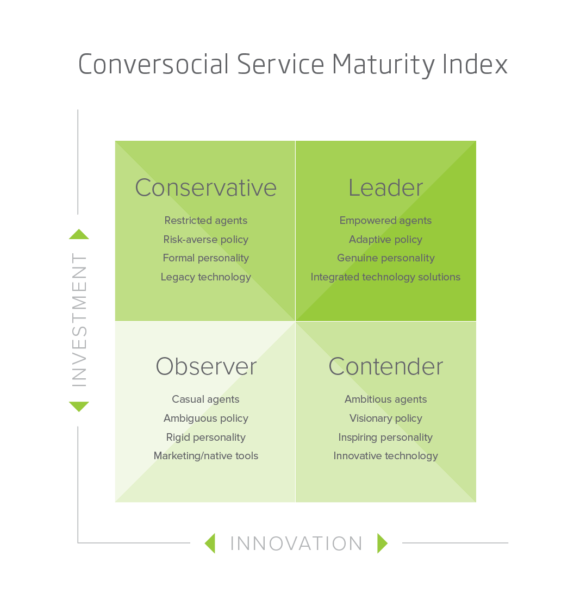— September 3, 2017
Social maturity is more than just showing up on social, and it takes far more than canned responses and expensive software. A truly, socially mature brand offers service on all channels, providing real-time responses that actually deliver resolutions. Its agents are warm, personable, know each customer’s entire cross-channel history, and are empowered to resolve issues in-channel and on the spot. This kind of company neatly side-steps social media crises by proactively rectifying issues before they bubble up. The support organization can annex additional budget because its ROI is clear. In fact, executives applaud it as a profit center and a key contributor to company growth.
Becoming a fully socially mature business is a long and challenging journey. Very few companies are there yet, although many feel they are. Being fully social maturity is an aspiration, just like ‘maximum productivity’ and every brand is on their own journey to get there.
Social maturity is a journey, not a destination
Social maturity occurs when you treat social just as importantly as you do as traditional channels. And it is clear that it’s vastly more effective than legacy support:
- Over half of consumers prefer social care – Adweek
- Agents with social care tools are 167% more efficient – Forrester
- Social care is 63% cheaper than phone support – Forrester
- Cooperation on social between marketing and customer care can increase revenue
How does a brand become socially mature? That’s determined by two factors: investment and innovation. Everything else, from company size to social volume, the size of your contact center, or whether you can be ‘edgy’ on Twitter, have very little to do with it.
Let’s break those factors down:
Investment: If you are putting the right emphasis on investment in social customer service, it means that you have accepted social as the powerful, growing channel for customer engagement it is. True investment in social customer service is not only indicated with financial ‘buy-in’ but also through the time invested, manpower allotted and executive attention given. What are the indicators of full investment in Social Maturity?
- A team of dedicated social agents, resourced in relation to volumes
- A best-in-class tool for each function of social engagement
- Executive visibility into KPIs and performance
- Full adoption of technology, cultural practices, and operations throughout the company
Investment does not just come down dollars and pounds. But it is nearly impossible for customer care teams to achieve social maturity without necessary resources and tools. Socially mature companies have successfully allocated investment toward these initiatives, both in terms of time, resources and money.
Innovation: Even with all of your ducks in a row on the investment side, you still fall short of the being fully social mature without a truly innovative outlook on social media engagement. In fact, when brands who have attained social maturity ratings slip, they do so not because of failures on the investment end, but because they stopped innovating. Modern customers are constantly evolving and technology and strategies must keep up. What are the indicators of robust innovation for socially mature brands?
- A cross-company tone of voice on social that is human and efficient
- Proactively driving volumes from traditional to social
- In-channel resolution for all queries
- Early adoption of new channels (e.g Messenger, WhatsApp, etc)
- Upserving over Social, contributing to future customer lifetime value
Social media is a wholly different animal from legacy channels like phone and email. Companies who are mature have tailored their approach to social, recognizing the different approaches needed, but remained human throughout.
Brands can climb the Social Maturity Index by focusing their efforts both in investment and innovation, and the combination of these two can show you where your brand falls on the Social Maturity Index.
The Social Maturity Index: In which quadrant does your brand fall?

Want to know where your brand belongs? Take our Social Maturity test to find out.
Note that the journey to social maturity isn’t a linear one. Brands can allocate investment but stagnate for lack of innovation and vice versa. Big companies usually have an easy time moving from Observer to Conservative, but a more difficult time getting to Leader. Small companies with less bureaucracy but shallow pockets find that Challenger status is easy, but coming up with the investment to reach Leader takes time.
Each company finds its own path, but all require focus. Brands who aspire to become social care experts and engage in unyielding investment and innovation will find that they move up the index and reap the rewards of leadership.
Digital & Social Articles on Business 2 Community
(58)








